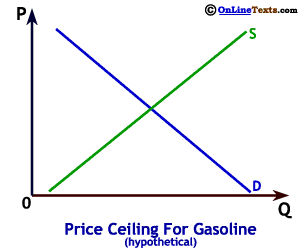
Next we consider policies intended to keep prices below the equilibrium price. Consider a hypothetical Price Ceiling on the price of gasoline, illustrated on the graph to the right. Suppose the equilibrium price for a gallon of gasoline were US$3.00 per gallon, with the average consumer purchasing 50 gallons per month. Suppose consumers convince the U.S. Congress to impose a price ceiling of $1.00 per gallon19 because $3.00 isn't "fair."
At a price of $1.00 per gallon, oil companies are only interested in supplying enough gasoline for the average consumer to purchase 18 gallons per month, but at that price the average consumer wishes to buy 80 gallons per month. At the lower level of output, frustrated consumers would be willing to pay far more than the $1.00 price to purchase a little more gasoline. From the demand curve we can see that if the oil companies only producing enough for each consumer to buy 18 gallons, consumers would be willing to pay $5.00 per gallon for a little more gasoline. Such a large difference, between the legal price of $1.00 and the consumers' willingness to pay would likely lead to a variety of illegal behaviors. What sorts of illegal behavior might we expect?


A variety of political and environmental reasons make it unlikely that the U.S. will ever impose a price ceiling on gasoline.